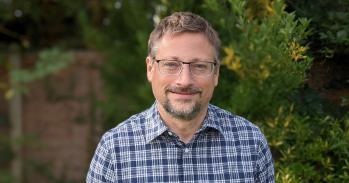
Nicky Clayton, Professor of Comparative Cognition in the Department of Experimental Psychology, has thrown the doors wide open on animal cognition. Where once the idea would have been dismissed that animals can re-experience the past and plan for the future, her imaginative studies have shown this inherent cleverness in crows.
Nicky Clayton, Professor of Comparative Cognition in the Department of Experimental Psychology, has thrown the doors wide open on animal cognition. Where once the idea would have been dismissed that animals can re-experience the past and plan for the future, her imaginative studies have shown this inherent cleverness in crows.
What inspires me is the curiosity and creativity of science, and the social and serendipitous meetings between people that lead on to discoveries.
Professor Nicola Clayton
Nicky Clayton has always been fascinated by birds – by their glamour and elegance, their movement and rituals, their melodies and labours. This abiding passion has taken her from studying birdsong in zebra finches to observing complex feats of cognition in members of the corvid (crow) family, which includes scrub-jays, British jays, ravens and crows. Moving from the University of California Davis to Cambridge’s Department of Experimental Psychology in 2000 with her colony of scrub-jays, she embarked on a series of experiments with colleague Professor Tony Dickinson that was to break new ground in comparative cognition. Their inventive experiments have shown that birds hide (or cache) food, remember where to recover it from at a later date, and even steal it from each other. Not only this, but by remembering past events (such as whether or not they would find breakfast in a certain room in the morning), the birds could take action for their future (by moving breakfast into the empty room the night before).
The widely held view had been that animals can learn things through experience but not through memory; this ability to mentally travel back through time – so-called episodic memory – was thought to be something unique to the human race. For the first time ever, these experiments showed that humans are not alone in being able to remember a past experience in terms of what happened, where and when.
Nicky Clayton’s research has already branched out to cognitive studies comparing corvids with great apes through a collaborative project with her husband, Dr Nathan Emery (Queen Mary, University of London). She is now also embarking on similar studies in young children with Dr Jim Russell in the Department of Experimental Psychology. These incredibly productive collaborations hold great promise for our future understanding of the workings of the brain in animals and humans.
What would others be surprised to learn about you?
A large part of my life is spent dancing – ballet, jazz, and particularly Latin dance like salsa and tango. Of course birds dance too: I have a favourite video clip that I show my students of the dance of the Swallow-tailed Manakin – it’s the avian equivalent of tango, and not surprisingly therefore they are found in Argentina! Two males perform a duet, a fabulous, showy double-act in which they display their beautiful plumage and synchronised movements. The males spend 90% of their time for nine months of the year dancing – a pretty intense avian dance school. This example encapsulates why I love dance: the elegance of movement, the colours, form, intensity and dedication – it strikes the core of my soul.
Who or what inspires you?
What inspires me is the curiosity and creativity of science, and the social and serendipitous meetings between people that lead on to discoveries. My academic hero is the late Bill Thorpe, Professor of Animal Ethology and founder of Cambridge’s Sub-Department of Animal Behaviour. He was an incredibly wise man and in many ways ahead of his time: he suggested that because bird brains are structurally different from the classic mammalian structure people shouldn’t assume that they are creatures of instinct. We now know of course that birds have quite impressive cognitive abilities.
Have you ever had a Eureka moment?
I suppose when Tony Dickinson and I first met – at the International Comparative Psychology meeting in Montreal in 1996 – and he said animals don’t need episodic memory. That got us talking and we began asking questions in a way that nobody else had been doing before. Out of that developed a wonderfully fruitful collaboration, with the result that four years later I moved here and we have been collaborating ever since.
What’s the best piece of advice you’ve ever been given?
Lord Krebs of Wytham, whom I worked with in Oxford, always emphasised the importance of balance in your life. His maxim was ‘healthy minds need healthy bodies’.
If you could wake up tomorrow with a new skill, what would it be?
I’d like to be able to dance flamenco. And I’d like to be reincarnated as a scrub-jay – imagine what it must be like to experience being part of this clever family of birds and find out what they really are thinking!
What motivates you to go to work each day?
That’s really easy: I love what I do. I love my days spent in research, in teaching undergraduates and graduates, in running a wonderfully supportive family-style lab, and last but by no means least, these long-term collaborations with my two best friends – Nathan, who is my husband and soulmate, and dear Tony. And I love releasing steam by dancing tango and salsa.
What is your favourite research tool?
My eyes and ears. For so much of the work I do what’s essential is detailed observation – looking and listening. It’s also important for dancing – being a good observer and a good listener helps you to copy the nuances of the rhythms.
This work is licensed under a Creative Commons Licence. If you use this content on your site please link back to this page.





